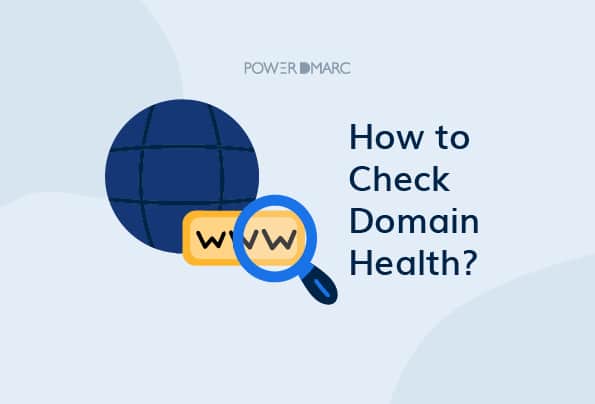It’s advised to regularly check domain health of your DMARC-compliant domains to stay shielded against phishing, spoofing, fraud, and impersonation attacks. Monitoring your domain gives you insights into your email security status and working conditions of SPF, DKIM, and DMARC, enabling you to take timely action and fix vulnerabilities before bad actors take advantage of them.
Over the last 5 years, the IC3 has registered 3.26 million complaints and reported total losses amounting to $27.6 billion. Numbers like these are loud signs indicating us to be rigid with our cybersecurity practices. So, don’t stay behind and start today by learning how to check domain health.
Why Should You Check Domain Health?
You should check domain health to have a steady flow of emails regularly. Moreover, domain analysis boosts your efforts if you have just started your email authentication journey. It gives you a detailed insight into all the records you have published for your domain and informs you about their status.
You get to know about errors like syntax issues, typos, usage of deprecated mechanisms, etc., and record configurations so that you fix them before a hacker takes advantage of these vulnerabilities. A non-erroneous record also gets you a higher score on your domain’s overall security rating.
How to Check Domain Email Security Health? – 3 Step Guide
To check domain health for your email domain’s security, use our free PowerAnalyzer tool that you can access on all plans, that too without pre-registering domains or login into your PowerDMARC account. Just follow these steps, and you can check your domain’s health.
Step 1: Click this link to go to our PowerAnalyzer tool.
Step 2: Enter the domain name whose health you want to check and click on Lookup.
Upon making the query, the tool will show you the following details at a glance:
- The domain name
- The date of the assessment
- ‘Export as PDF’ button
- A grade score
- A numerical percentage score
Note that it’s recommended to specify a DKIM selector for a higher grade since its participation is critical to the score calculation algorithm. You can add it by typing it in the defined section while analyzing your domain using our tool.
How will this help you?
- Get a consolidated email security score to determine your domain’s health against email fraud
- Discover anomalies, and errors in your implemented protocols
- Discover room for improvement
- Explore troubleshooting measures
How to Improve Domain Health?
Now that you know how to check domain health let’s see what you can do to improve it if the score is low.
Configure Your SPF, DKIM, and DMARC
Properly configure SPF, DKIM, and DMARC to ensure only legitimate and trusted entities send emails using your domain, and you get a high domain health score for email security and compliance practices.
Avoid or Minimize the Use of Spam Words
Certain words can make your email perceived as spammy by mailbox providers. Some common words are- free, buy, score with babes, XXX, additional income, earn extra cash, work at home, work from home, etc.
The list of negative or spammy words varies from business to business and industry type. So, research what are considered sales-y words in your work field. More importantly, avoid their use in the subject line if you have already used them in the email body. You definitely don’t want your email efforts to be marked as spam.
Include Single/Double Opt-In Links Within Your Emails
If you send bulk emails and don’t include an option to unsubscribe from the list, your domain health is likely to get low. Single opt-ins and double opt-ins let recipients choose whether or not they would like to continue receiving emails from you.
Adding these links indicates ESPs and ISPs that either the recipient voluntarily signed on to receive this email or a way is there to stop these emails from being received if they aren’t interested or find the information useless.
Warm Up Your Domain
You need to warm up your domain if it’s new, has little engagement, or had spam issues in the past. This warm-up drill improves IP reputation, which is important before strategizing a PR, sales, or marketing campaign.
If ISPs spot a drastic spike in the number of emails sent, your domain or email account is marked as suspicious, which may cause your emails to be delivered to the spam folder or get rejected outrightly. So. strategically warm up your domain by gradually increasing the number of emails you send per day. This way, you won’t trigger ESPs’ anomalies.
Maintain Your Mailing List
Time-to-time clean-up of your mail list boosts your domain’s health. Start by focusing on bounced emails; check why exactly they are bouncing and try to fix the issues. This should be followed by cleaning up the unsubscribed and invalid addresses. You can use online tools to validate your email list and delete invalid, fake, and disposable email addresses from your database.
Try mailing and confirming recipients of old subscriptions, inactive emails, and passive engagement if they wish to continue receiving messages from you.
Avoid Getting Blocklisted
Not being compliant with best and safe practices and being repeatedly reported as spam can blocklist your domain.
Where Do We Fit into Your Domain Health Lifecycle?
Our PowerAnalyzer tool lets you perform a free analysis of your domain. On entering your domain name and running a quick check, you instantly get a detailed DMARC analysis report for that domain. This report highlights the status of your DNS records, their validity, and existing errors, along with valuable suggestions for fixing them.
So, perform your first analysis now!
- Rise in Tax Scams and IRS Email Impersonation Attacks During Tax Season - May 2, 2024
- Email Safety 101 to Fight Crypto Scams - April 30, 2024
- How to Find the Best DMARC Solution Provider for Your Business? - April 25, 2024
